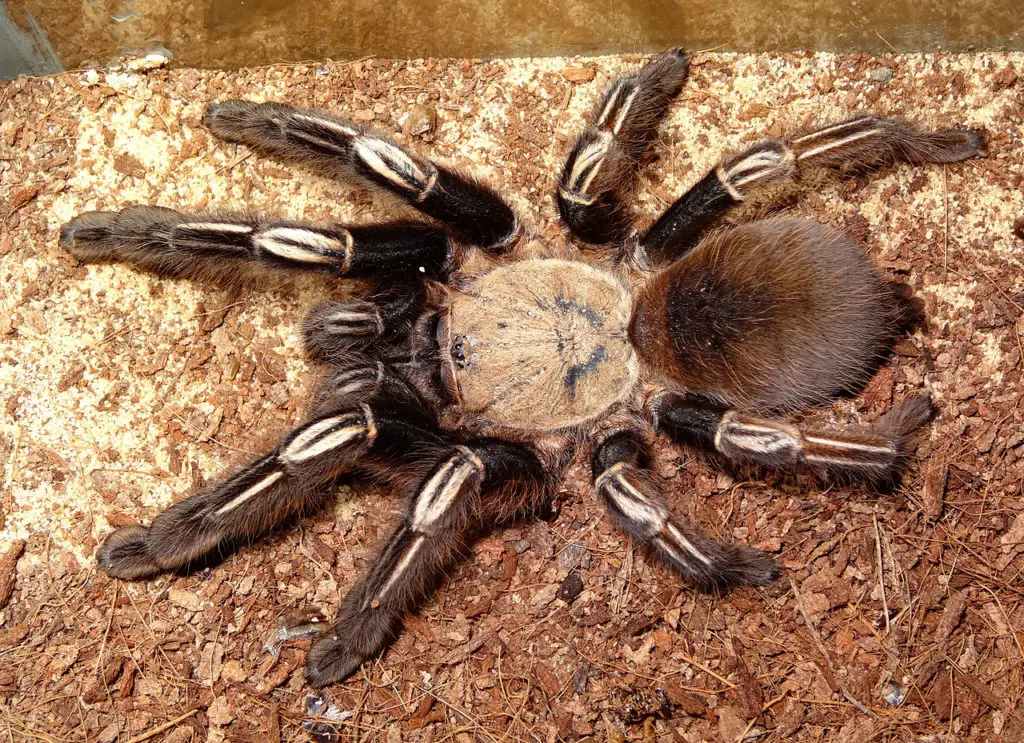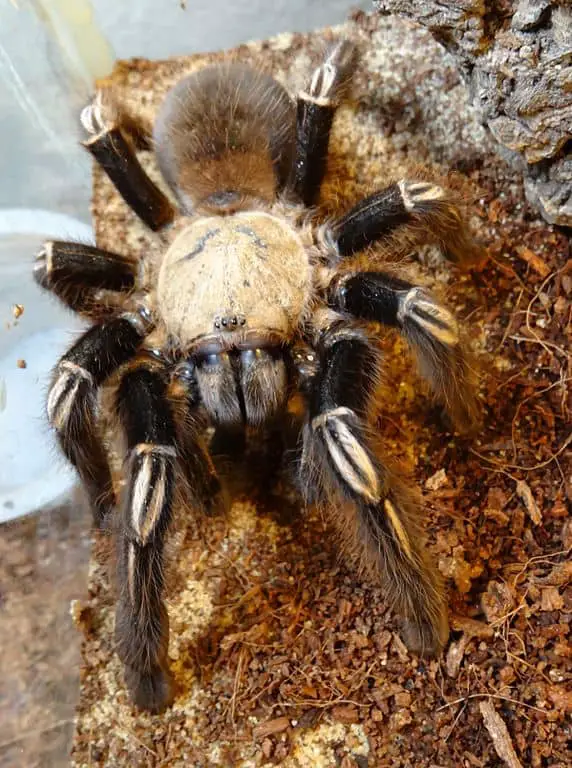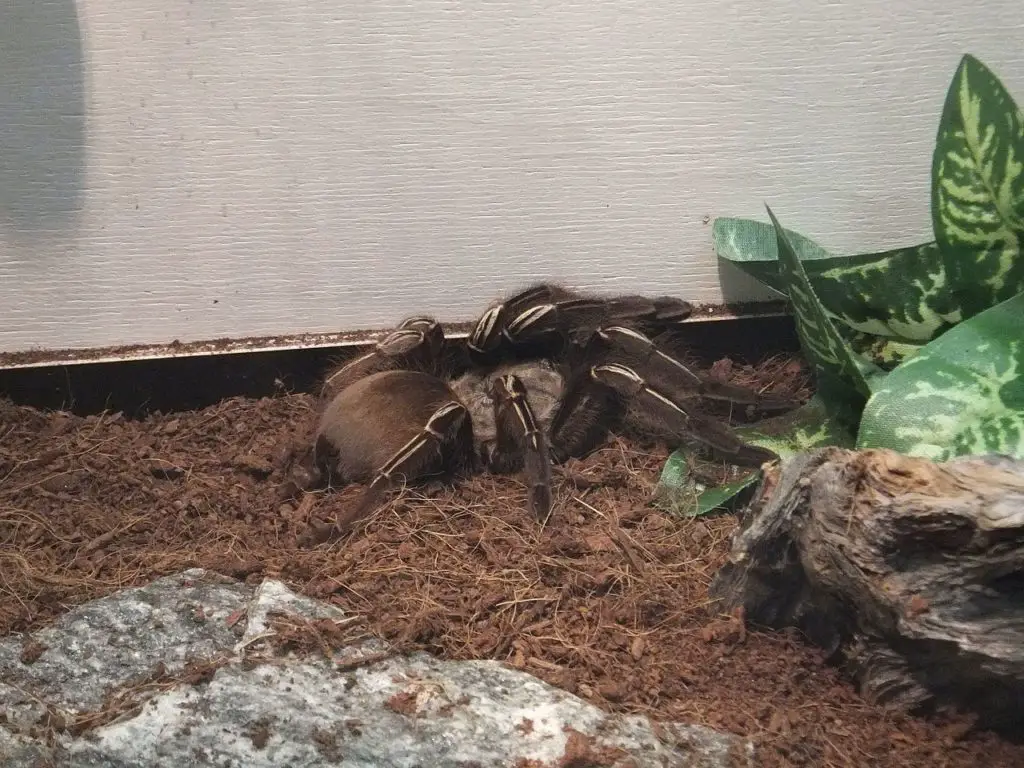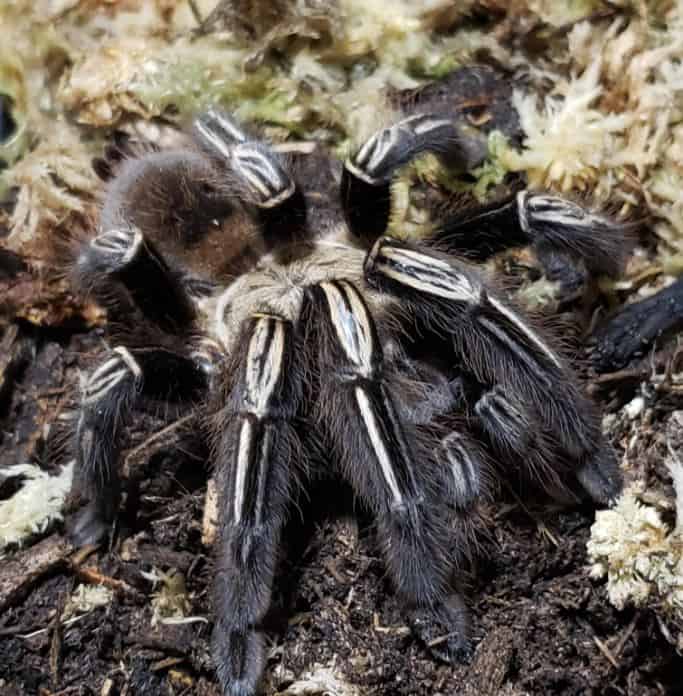The Skeleton Tarantula (Ephebopus Murinus) is a New World terrestrial tarantula species that is well-known for its unique skeleton pattern. They natively inhabit the rainforests of Brazil, Frech Guyana, and Suriname, but are also highly desired as pets.
With over 800 tarantula species having been identified globally, it can be difficult to decide which species suits you best as a pet. Today, we’re taking an in-depth look at the Skeleton Tarantula to discover whether this unique spider is a good fit for you.
So, if you’re interested in adding this species to your collection, then continue reading because we’ll tell you everything you need to know about this fascinating arachnid.

Skeleton Tarantula Care Sheet
| Species Name | Ephebopus Murinus |
| Family Name | Theraphosidae |
| Common Name | Skeleton Tarantula, Yellow Knee Skeleton |
| Category | New World |
| Type | Terrestrial |
| Native Location | Brazil, Guyana, Suriname |
| Leg Span | 4.5″ for males, 6″ for females |
| Growth Speed | Medium |
| Urticating Hairs | Yes |
| Social | Solitary |
| Diet | Crickets, roaches, mealworms. Also capable of feeding on small mammals in the wild. |
| Temperature | 75 to 80 Fahrenheit |
| Humidity | 80% |
| Life Expectancy | Females, 15 years. Males, 3 to 4 years |
| Recommended Experience Level | Intermediate/Advanced |
| Minimum tank size | 18”x18”x12” |
Skeleton Tarantula Overview
The Skeleton Tarantula is also sometimes referred to as the Yellow Knee Skeleton. Its scientific name is Ephebopus murinus. This peculiar spider lives on the forest floors in the Americas, making it a terrestrial New World species.
The exact location where the Skeleton Tarantula is found is Brazil, Guyana, and Suriname. The damp and warm climate of these countries makes for the perfect natural habitat for this unique species. The environment of Brazil is tropical throughout the year with a few months of very heavy rainfall.
They are a fossorial species and were first found 6-8 inches below the ground, in burrows.
The interesting thing about this particular tarantula is that when it comes to keeping them as a pet, their lifestyle, behavior, habitat, etc, differs quite significantly from other species.
Appearance and varieties

The appearance of this species is very unique. From its common name, the Yellow Knee Tarantula, it’s evident that they have yellow stripes on their black legs with a brown stripe (in the middle). The carapace takes on a yellowish golden hue.
Their abdomen is a light brown shade. The abdomen of this tarantula is quite small compared to that of other species, while their legs are relatively long.
The skeleton-like yellow pattern can be seen very early on in the Skeleton spiderling. This is because the growth rate of this tarantula is significantly faster in comparison to other species.
Another interesting physical characteristic of the Skeleton Tarantula is its size. Compared to some other massive species, the average adult has a relatively small size. Males are significantly smaller than females. Males typically grow to a size of about 4.5 inches whereas females can grow to a size of 6 inches.
Price
Irrespective of where you are in the world, getting your hands on a Skeleton Tarantula is usually relatively simple. You can find many breeders online that sell Skeleton Tarantulas.
The good news is that even though the Skeleton Tarantula is a rare and exotic species, you can get a sling for as low as $25 to $35.
The adult males and the females cost $75 and $100 respectively. Males are typically cheaper because they have shorter lifespans.
So, in terms of buying such a tarantula, it’s going to be quite affordable.
Behavior and temperament

It’s best to have some amount of experience if you play on keeping a pet Skeleton Tarantula. Being an intermediate or experienced keeper that knows their way around big spiders makes you better suited to care adequately for this spider. This is primarily because of their temperament and behavior which can be tricky for newcomers.
The Skeleton Tarantula isn’t a tarantula that you can hope to be hands-on with. Although their venom is of mild toxicity and is thus not all that dangerous to humans, they do have a defensive demeanor.
You may experience a strong stinging sensation with a sharp bite if they manage to set their fangs into you, which is something they will definitely try to do if they feel threatened.
Their relatively small size combined with their agile nature allows them to move around quite quickly. So, don’t try to be very hands-on with them and be careful when interacting with them.
In terms of temperament, although they can seem quite aggressive, they’re more defensive and are more likely to flee than fight in an encounter with something they perceive as a predator.
Like other new world species, they also have urticating hairs which they can kick when they feel threatened. Something that sets them apart is that they release their urticating hairs from their pedipalps, whereas most species release them from their abdomen.
Caring for a Skeleton Tarantula
Tank size
Owing to the fact that the Skeleton Tarantula is a terrestrial and burrowing species, the ideal enclosure for such a species would be an 18”x18”x12” glass terrarium.
This size is perfect for adults because it’s enough for them to be able to dig their burrow. Secure doors are necessary given that they tend to move around fast.
Humidity
This spider requires a humid environment to thrive. However, make sure that the cage isn’t damp, just humid. 80% humidity is ideal. You can do this by slightly overfilling the water bowl or spraying one side of the cage a few times a week.
Adequate ventilation is also important.
Temperature
Although this species originates from a tropical environment, it doesn’t require very high temperatures to survive. The ideal temperature range would be between 75-80°F.
Substrate
It’s best to have at least 6 inches of substrate for this tarantula as they are a terrestrial burrowing species. Ideal substrate options for such species are soil-based ones or sedge peat and coconut fibers.
Foliage
Cage furnishings for their enclosure include a sizable hide. This is a must. Apart from an adequate hide, you can include plants, rocks, and moss in the enclosure.
Communal living
While some tarantula species are capable of living communally, the Skeleton Tarantula is not one of those species.
This spider is territorial and should not be housed in groups. If you house them in groups cannibalism is extremely likely to occur. To keep your tarantula safe, make sure that they only meet other members of their species if they’re going to mate.
Health & Lifespan
Skeleton Tarantulas have a long lifespan, especially the females can live for long periods of time. Whereas males typically live for around 3 to 4 years, females can live for up to 15 years!
As pets, it’s quite easy for them to live out their entire natural lifespan due to the fact that they do not have to worry about predators when kept in captivity. In addition, they’ll be well-fed because we provide them with food.
To keep your tarantula healthy it’s important that you make sure that you feed them captive-bred prey insects. Wild-caught insects are not recommended because they can contain parasites.
In addition, make sure that the temperature in their enclosure is suitable for them and that you remove uneaten food and previous molts. That way, you can prevent the growth of bacteria and mold.
If you keep these things in mind the Skeleton Tarantula should be able to thrive in captivity.
Watering
Remember to keep a water dish in the enclosure at all times. Keep a shallow water dish to avoid any drowning possibility and change the water in the dish regularly. This is to avoid health complications arising out of fungal or algal growth.
Feeding a Skeleton Tarantula

The good news is that this species is not a fussy eater. Roaches, mealworms, crickets, and other insects are perfect. You can also feed them small mammals such as mice (pinkies).
However, these small mammals should only be given occasionally and they’re not a necessary part of their diet. Many owners feed their Skeleton Tarantula nothing but insects and that is perfectly fine.
It’s best to avoid creatures that are bigger than the tarantula’s size in order to keep them safe.
As slings, they should be fed small insects such as larvae and flightless fruit flies. As they get bigger they can start feeding on larger prey. However, it’s best to avoid creatures that are bigger than the tarantula’s abdomen in order to keep them safe.
Breeding the Skeleton Tarantula
Before you start breeding the Skeleton Tarantula make sure that the female is well-fed, as this makes her more receptive to the male’s advances. In addition, breeding should be done soon after molting. The reason why is because females are unable to produce a viable egg sac while molting.
If the female is well-fed and has recently molted, place the male into the female’s enclosure. Keep an eye on them to see if everything goes okay. If something goes wrong, separate them. Also, separate them after they’ve successfully bred.
The female tarantula’s egg sac (created within four months after breeding) houses 50-100 spiderlings.
Remember that this tarantula is best kept by a keeper with an intermediate to advanced level of experience and that breeding is not something you should attempt to do on a whim. Proper breeding is difficult and will result in hundreds of slings which can be difficult to house. It’s best to leave the breeding to experienced experts.
Ephebopus Murinus Facts
- The Ephebopus Murinus gets the common name “Skeleton Tarantula” due to the interesting pattern located on their legs.
- The species was first described in 1837 as Mygale murina by Charles Athanase Walckenaer but has changed names and genera several times since then.
- The Ephobopus Murinus is a heavy webber.
Final words: Is the Skeleton Tarantula right for you?
The Skeleton Tarantula is without a doubt a unique-looking spider. The skeleton pattern that gave them their name is a feature that separates them from the other species. As a result, they’re highly desired among people in the hobby.
With that being said, they’re definitely not for everyone. Experienced caretakers might be able to handle them, but newbies are better off getting their feet wet with a more docile species like the Antilles Pink Toe or Greenbottle Blue first.
- How Long Do American Eskimo Dogs Live? Important Factors and Care Tips - September 29, 2023
- Do American Bulldogs Need Grooming? Essential Tips and Care Guidelines - September 29, 2023
- Do Bengal Cats Enjoy Playing? Essential Tips for Keeping Them Active - September 29, 2023